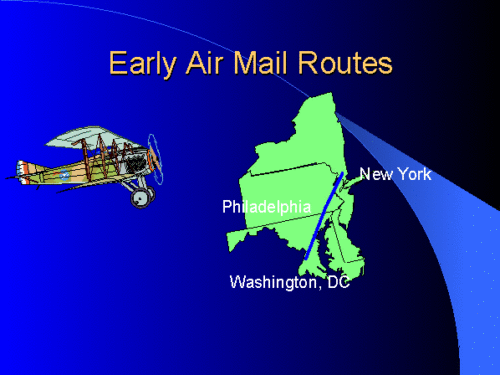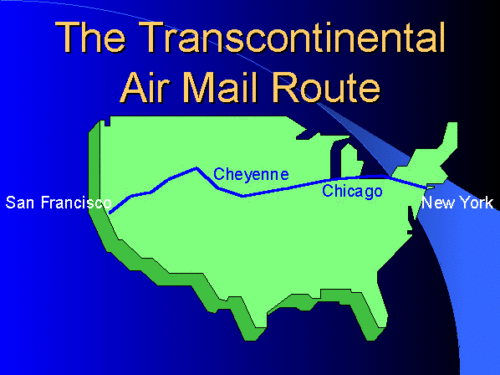By John Schamel
Introduction
Our nation’s current system of air transportation – airlines, airports, and air traffic services – can trace its roots back to the original concept for exploring and promoting aviation in the United States. The history of two government organizations – The National Weather Service (NWS) and the Federal Aviation Administration (FAA) – is tied to the excitement and adventure of flying.
Birth of Aviation
The Wright Brothers made the first powered flight in a pilot controlled aircraft on December 17, 1903. The flight was the first to experience weather delays – the original date for the flight was December 14.
Early Applications
Most flying done between 1903 and 1914 was for sport. Only the wealthy could afford such expensive toys as airplanes, although many sacrificed their time and savings to participate in the great air races of the time. Many were lured by the large prizes offered. Although greatly debated by the press and other ‘experts’, many believed that aviation would not have any commercial application. Airplanes of the day were too slow, too small, and still unreliable. There was another group, though, that had a novel idea. Since Heaven was above the clouds, they firmly believed that airplanes would one day allow us to visit Heaven. They saw a wondrous future for aviation, as the link between the Heaven and Earth.
Various nation’s looked at the early airplane as a possible new weapon for their arsenals. Limited use of the airplane in the Balkans and in Mexico showed that it could assist armies with scouting and observation duties.
World War I was the first proving ground of aviation. From a few unarmed airplanes limited to scouting and observation duties in 1914, the military use of air power resulted in the development and mass production of fighters, bombers, observation, and training aircraft by 1918.
World War I showed that the airplane was a usable tool for military application. But was there a viable commercial application?
The Air Mail Experiment
The US Army was constantly trying to find more uses for the airplane. A proposal to carry mail was made in early 1918. On May 15, 1918, the first air mail flight was made from New York to Washington, DC by an Army pilot in an Army aircraft. The first trip wasn’t spectacular. In fact, the pilot got lost and landed at the wrong airfield!
Subsequent flights had an 80% success rate, but the routes were too short – there was no significant savings over trains. Additional routes were established towards Cleveland and Chicago.

In August,1918, the US Post Office Department took over the air mail system. Army pilots became postal employees, bringing their airplanes with them.
By 1919, air mail routes continued to grow to the west. Flights between New York and Cleveland cut 16 hours off the time it took mail to travel by train. Plans were made to extend the air mail route all the way to the West Coast.
The Transcontinental Air Mail Route
Officially opened on August 20, 1920, the Transcontinental Air Mail Route was the first airway to extend from coast to coast. It stretched from New York to San Francisco. Along its 2,612 mile length were 17 Air Mail Radio Stations (AMRS). These were the first air traffic service facilities ever constructed.

Air Mail flights were daytime only flights. Aircraft would be loaded with mail and would fly until darkness or weather required them to land. The mail was then loaded on a train and continued to travel at night. At dawn the next day aircraft on the route would receive new mail bags and continue their journey. There was no ‘air mail’ per se – local postmasters picked bags at random to send to the airfield.
The Transcontinental Air Mail Route and the other shorter routes along the East Coast became the proving ground for US Aviation. Tested on these routes were:
- Aircraft and aircraft instruments
- ground based navigational facilities and navigational charts
- Airway structuring
- Air to ground radio
These early pioneers blazed the trail for others to follow. The demand for better planes, better radios, ground based radio navigation, and better weather information during the 1920s set the stage for the beginnings of passenger airline service in the 1930s.
Did You Know …?
The Civil Aeronautics Administration (CAA) used civilian controllers to develop and operate the South Atlantic Bridge in Word War II. This bridge was the air link from the U.S. to the fighting forces in North Africa and the Mediterranean.
Many air traffic facilities were staffed entirely by women during WWII.
The first federal teletype system was implemented in the early 1930s to pass weather and flight information between air traffic facilities.
The first aviation weather forecast (specifically for pilots) was written by the US Weather Bureau in 1914.
Some Interesting Dates in Aviation History
1919 – President Wilson proposes that the Commerce Department license pilots, inspect and register aircraft, and supervise the use of airfields. Congress took no action on his proposal.
1923 – Light beacons are added to the Transcontinental Air Mail Route between Chicago and Cheyenne, allowing night flights.
1924 – regular scheduled flights are started along the Transcontinental Route.
1925 – The Kelly Air Mail Act puts the Post Office out of the flying business. Specific segments of the air mail routes are put out for bid. The early airlines are formed as contract mail carriers.
1926 – The Air Commerce Act is passed by Congress and signed into law by President Coolidge. Then Secretary of Commerce Herbert Hoover creates the Aeronautics Branch to handle these new responsibilities. Its first budget – $550,000!
The Weather Bureau was a part of this Act, and was tasked with providing better weather services along the airways and at airports.
May 1927 – Lucky Lindy’s solo flight to Paris, France.
June 1927 – The Transcontinental Air Mail Route is turned over from the Post Office to the Commerce Department. By this time, it had 92 airfields, 518 light beacons, and the original 17 Air Mail Radio Stations. The route was staffed by 45 radio operators, 14 maintenance mechanics, and 84 caretakers.
Also in June, the Commerce Department offers the first aeronautical charts for sale.
July 1927 – the first ground-to-air radio conversation, conducted at a range of 50 miles.
August 1927 – a 1,000 watt radio station establishes contact with an aircraft 150 miles from the station.
February 1934 – the Airmail Scandals force Congress to cancel all contracts pending a sweeping investigation. The US Army takes over flying the mail until June. Serious deficiencies in Army training and equipment are uncovered, causing another scandal in the press.
The Air Mail Act of 1934 restructures the mail contracts. FDR appoints a Federal Aviation Commission to look at commercial aviation. The future course of US aviation and air commerce is set.
1934 – the first control tower is built in Cleveland.
1936 – The airlines establish three en route centers in Newark, Cleveland, and Chicago. These are later taken over by the federal government.
1938 – The Civil Aeronautics Act creates the first CAA – Civil Aeronautics Authority. Airport and Airway Traffic Control Sections are established.
1940 – The CAA is reorganized into the Civil Aeronautics Administration. Airport Towers are taken into federal service. The CAA receives support and guidance from the War Department to expand and improve the air traffic system.
About the author …
John joined the FAA in 1984 and has been an Academy instructor since 1991. He taught primarily in the Flight Service Initial Qualification and En Route Flight Advisory Service programs. He has also taught in the International and the Air Traffic Basics training programs at the FAA Academy.
History has been an interest and hobby since childhood, when he lived near many Revolutionary War and Great Rebellion battlefields and sites. His hobby became a part time job for a while as a wing historian for the U.S. Air Force Reserve.
John’s first major historical project for the FAA was to help mark the 75th Anniversary of Flight Service in 1995.